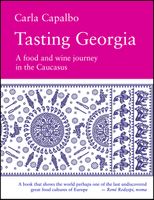Advertisement
Qvevri Maker
Vardisubani Zaza and Remi Kbilashvili
Published 2017
This qvevri maker’s pottery is just outside Telavi on a country lane of independent houses. The heart of Zaza and Remi Kbilashvili’s family business is their studio. Unusually it’s located right under their house: they craft their qvevri in its cool, low-ceilinged semibasement. When I visited in June, the batch of qvevri the men were making was almost finished and the space was crowded with high, round-bellied clay vessels. The house suggested a mother hen sitting on a clutch of eggs.
“My family has been making qvevri for at least five generations,” says Zaza who, like his father, is a master qvevri maker. “We’ll put ‘necks’ on these qvevri to finish them. Climate – and micro-climate – are very important. You can only make big qvevri in warm months but summers here are hot so we’re careful to dry them slowly for two to three weeks before firing. You can’t rush or cracks might appear.” Qvevri can hold up to 2,000 litres of wine.

